So . . . .about two weeks ago I had a dream, (actually more of a nightmare) in which I was asked to judge a contest to choose “the best photograph of the Gates” from among three million orange photos. Over the next few days, however, the more I thought about it,I became intrigued by the idea of seeing people’s different creative solutions to photographing the gates.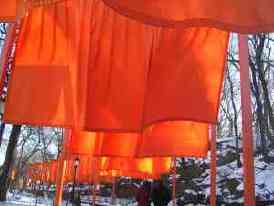
[Note: I loved the Gates. Ashton (partner-in-crime) and I were in the park almost every day we were in the city, we even gave a party for 150 friends who came from all over the world to walk through the park at dawn (see nifty video by alex itin, orange you glad).
On the last day Ashton and I walked through the park for seven straight hours with Rebeca Mendez and Adam Euwens — talking almost the whole time about the phenomenon of the Gates — as an art work that requires significant effort on the part of its audience; like all of Christo and Jeanne-Claude’s work, it requires you to be at a certain latitude and longitude at a specific moment in time; you need to see it from different vantage points at different times of the day; as Ashton said, “there are as many views of the Gates as footsteps in the park.”
And of course you talk endlessly to the people you meet along the way.
Early that last day, high up on the Harlem Meer, we came upon a big man with red orange hair who was quickly slipping a big coat over his obviously naked body. His friend had just as obviously been taking pictures. Ashton and Rebeca immediately realized that they were taking pictures of his orange pubic hair against the backdrop of the Gates. Impulsively I mentioned that I was planning to sponsor a contest for the best amateur photograph of the Gates. Surprisingly they wrote down a URL for the competition I made up on the spot. A few other times during the day I mentioned this to people who seemed to be taking interesting photos. Without any prompting, they also wrote down the URL.
So the next day, Monday, while sitting around the table with Kim, Dan, and Ben, my colleagues at the Institute for the Future of the Book, I mentioned the whole Gates photo idea and to my delight everyone thought it would fit in perfectly with our experiments in the area of open-ended networked “books.”
Voila — the beginning of the Gates Memory Project which we are launching today at gatesmemory.org. It’s quite a bit more ambitious than the original (and impossible) idea of choosing “the best photo.” Now we are aiming to to harness the creativity and insight of thousands to build a kind of collective memory machine — one that is designed not just for the moment, but as a 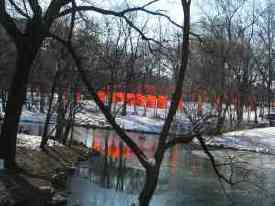 lasting and definitive document of the Gates and our experience of them. As Ben Vershbow says in the press release announcing the project, “The photographs are a jumping off point for further exploration. Ultimately, we are interested in collecting anything that can be shared over the web – film, audio, text – parodies and remixes.”
lasting and definitive document of the Gates and our experience of them. As Ben Vershbow says in the press release announcing the project, “The photographs are a jumping off point for further exploration. Ultimately, we are interested in collecting anything that can be shared over the web – film, audio, text – parodies and remixes.”
While the photos and stories are being collected, the institute will encourage discussion and debate on how best to present the archives in hopes of finding new, unexpected ways to view and bring meaning to the content. The institute also welcomes the possibility of collaboration with designers, developers and web curators. This project is the beginning of a long-term exploration for us. Through this work, we are asking: how do we use social software to create works that are in the spirit of the web – i.e. free-form, ad hoc, always evolving, and driven by people’s enthusiasm to share – but are also edited and shaped into something of lasting value? It is that tension – between frozen and fluid works – that we aim to explore. We are excited to see the ideas people will bring to the table.
See the complete call for the project HERE.
Author Archives: bob stein
curling up with a good movie
i spent the better part of the weekend in a marathon viewing of the first season of 24 — the thriller TV show which has 24 episodes, one for each hour of a specific day. the first season (season four is on the air now) takes place on “the day of the california presidential primary” and follows the brilliantly interwoven story of politics, espionage and family relations. a non-stop roller-coaster ride with deligtfully unexpected and usually believable plot twists.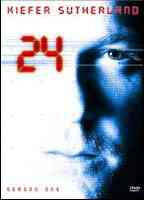
i watched 24 on a set of DVDs; most of the time the screen was on my lap (via my apple notebook) or right in front of me on a table. the intimacy of watching in that way, plus the duration created an experience that was much more akin to reading a novel you can’t put down than watching a movie or tv show.
it would have been even more interesting and more novel-like if all 24 episodes were available simultaneously with a complete index of scene content and dialog so that i could have gone back to review key scenes the way you can in a book.
not arguing here that there are no differences between novels and films, but that some of what makes a book a book — random access and intimacy — can be found in new media and you can see the seeds of new forms of expression. figure that people coming out of film school in the next ten years will find themselves going in one or two ways; either making giant spectacle films intended for 3D imax or making very dense, intimate novel-like “films” that are intended for an audience of one at a time.
the chilling effect of copyright law
excellent article in the Toronto Globe and Mail today about the chilling effect of copyright law on documentary films. initial subject is Eyes on the Prize, the superb documentary of the civil war struggle in the U.S., which is no longer shown on TV or distributed because the rights to the historic footage have run out and the producer’s cannot afford to re-purchase them in today’s hyper-inflated rights market.
capturing the early history of interactive media
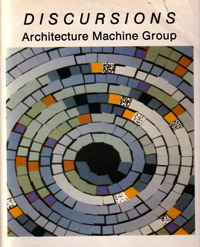 some of the most important early work in interactive media took place at the Architecture Machine Group Laboratory at MIT (now the Media Lab). twenty years ago the lab made a videodisc, Discursions, containing videos of several key experiments. this early work at MIT was crucial in terms of fueling and defining my ideas about interactive media (see books unbound article).
some of the most important early work in interactive media took place at the Architecture Machine Group Laboratory at MIT (now the Media Lab). twenty years ago the lab made a videodisc, Discursions, containing videos of several key experiments. this early work at MIT was crucial in terms of fueling and defining my ideas about interactive media (see books unbound article).
yesterday i met with a group of freshman in the interactive media honors program at the University of Southern California who signed up to work with the institute on presenting the Discursions material in some as-yet-to-be-decided form. the response was fantastic. (remember, these are young kids — none of whom were even born when Discursions was made). i know “awesome” is an overused word today, but that’s a good description of what the students thought of what they saw. many of the experiments seemed as if they could have been done yesterday and they grasped the importance of making the work available to young people working in the field now. any fears i had that my interest in the Discursions material was merely an oppty. to walk down memory lane disappeared immediately.
we’re planning to interview as many of the original researchers as possible, hoping that they can contextualize the work in terms of both its origin and its trajectory over the past twenty years.
elegant map hack
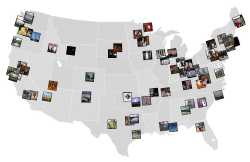 i’m not sure how i missed it till now, but until two days ago i’d never heard of Flickr (the photo management tool and community). now i’ve seen at least a dozen references in the past 24 hours. the most recent is Mappr, a wonderfully elegant hack from Mike Migurski and Eric Rodenbeck of Stamen Design who have used the information people tag their photos with to make a real-time map of recent photos posted to Flickr.
i’m not sure how i missed it till now, but until two days ago i’d never heard of Flickr (the photo management tool and community). now i’ve seen at least a dozen references in the past 24 hours. the most recent is Mappr, a wonderfully elegant hack from Mike Migurski and Eric Rodenbeck of Stamen Design who have used the information people tag their photos with to make a real-time map of recent photos posted to Flickr.
makes me think about the possibility of a real-time “community of readers” which allows you to see everyone in the world who is reading the same electronic document you are (assuming they have “opted-in” and allowed their names to be public).
new ebook sighting (hardware)
 a french company has released a new ebook, the Cybook, which seems to have a decent size-screen (10″ diagonal) and runs most of the e-book software formats.
a french company has released a new ebook, the Cybook, which seems to have a decent size-screen (10″ diagonal) and runs most of the e-book software formats.
but . . . it’s very heavy (2.2 pounds), has a relatively low resolution (72 dpi running at 800×600), won’t be visible outside; doesn’t come standard with wireless connectivity etc.
contrast to the Sony LIbrie which has similar dimensions but is only 1/4″ thick and weighs only 8oz., and uses an e-ink substrate rather than an LED so it is visible even in sunlight. of course the Librie is black and white, doesn’t support video, doesn’t connect to the net etc.
my guess is we’re still a couple of years away from a reading device that people can really get excited about.
Three Books That Influenced Your Worldview: The List
Yesterday I was thinking about the fact that books were the crucial element in the formation of my world view and wondered if that is the case with younger people. My guess yesterday morning was that people over 40 would easily come up with a list of books that influenced their way of looking at the world. Also – and this was probably the key idea I was testing – I assumed that when baby boomers came of age, specifc books (let’s say a dozen titles) were a crucial element in a shared cultural zeitgeist. By contrast, today I don’t see particular titles dominating the scene as they did 35 years ago.
Well . . . turns out I was pretty much wrong, at least as far as the 100+ people in my 40+ and 35- sample groups were concerned. Very few titles made it on to more than one list and I don’t see dramatic differences in the lists based on age.
One remarkable fact which you’ll notice when you look at the lists is the fantastic diversity in print culture. One can only dream that we will one day have such rich variety among works which are born digital.
This experiment of course hints at the bigger question: are books as important today in terms of forming world view as they were 35-40 years ago, and if not, what is taking their place? Most importantly: if not, what effect does the shift in dominant media have on the creation of world view?
If this gets anyone’s juices flowing, we’d love to have suggestions about how to explore these questions further.
Continue reading for the list…
